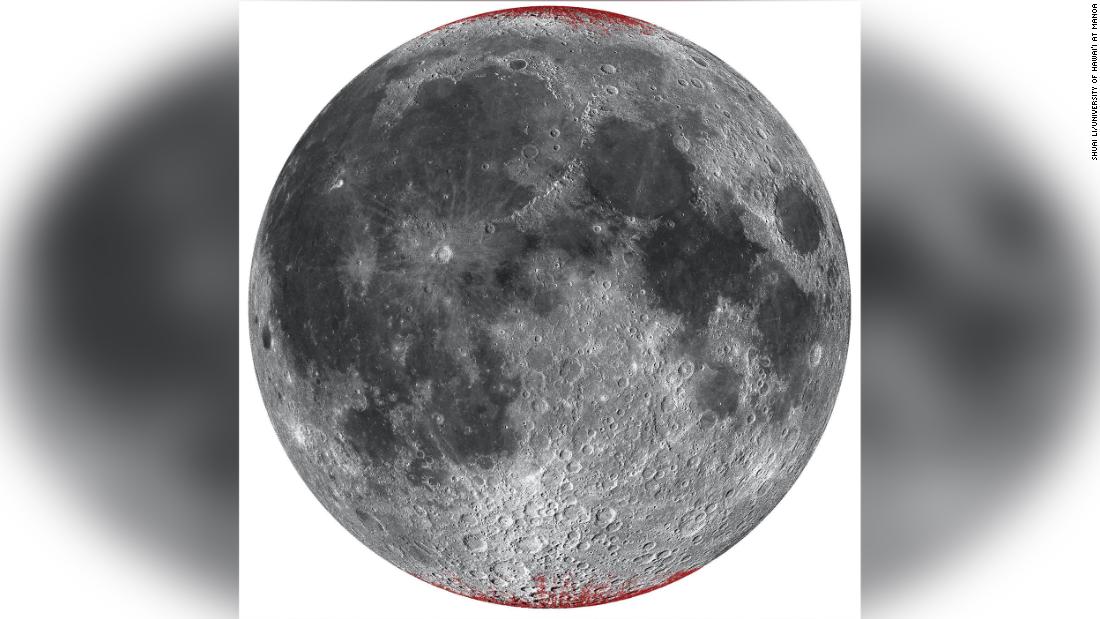This test brings NASA closer to returning to the Moon 0:58
(CNN) -
The Moon is rusting.
The scientists had the same reaction that you probably had when they came to this conclusion.
It shouldn't be possible;
after all, there is no oxygen on the moon, one of the two essential elements to create rust, the other is water.
But the evidence was there.
India's lunar probe, Chandrayaan-1, orbited the moon in 2008, collecting data that has led to numerous discoveries over the years, including the revelation that there are water molecules on its surface.
The probe also carried an instrument built by NASA that could analyze the mineral composition of the Moon.
When researchers from NASA and the Hawai'i Institute for Geophysics and Planetology analyzed the data recently, they were surprised to find signs of hematite, a form of iron oxide known as rust.
There are many iron-rich rocks on the Moon, but rust only occurs when iron is exposed to oxygen and water.
MORE: NASA receives signal from the Moon after more than a decade of attempts
At first, I didn't fully believe it.
It shouldn't exist based on the conditions present on the Moon, "said Abigail Fraeman, a scientist at NASA's Jet Propulsion Laboratory, in a press release.
Not only is there no air on the Moon, but it is awash with hydrogen flowing from the sun, carried by the solar wind.
Rust occurs when oxygen removes electrons from iron;
hydrogen does the opposite by adding electrons, which means it is more difficult for oxide to form on the hydrogen-rich moon.
"It's too intriguing," said Shuai Li of the University of Hawaii, lead author of the study, which was published Wednesday in the journal Science Advances.
"The Moon is a terrible environment for hematite to form."
After months of research, Li and NASA scientists believe they have figured it out, and the answer to the mystery lies on our own planet.
This is your theory
One important clue was that the oxide was more concentrated on the Earth-facing side of the moon, suggesting that it was somehow linked to our planet.
The Earth is enveloped in a magnetic field and the solar wind stretches this bubble to create a long magnetic tail in the direction of the wind.
The Moon enters this queue three days before it is full, and it takes six days to cross the queue and exit the other side.
During these six days, the Earth's magnetic tail covers the surface of the Moon with electrons and all sorts of strange things can happen.
Dust particles on the Moon's surface could float off the ground and dust from the natural satellite could turn into a dust storm, according to NASA.
An enhanced map of hematites (dust) on the moon, shown in red using a spherical near-side projection.
And, Li speculated, oxygen from Earth travels on this magnetic tail to land on the Moon, where it interacts with lunar water molecules to create rust.
The magnetic tail also blocks almost all of the solar wind during a full moon, which means that the Moon is temporarily shielded from the hydrogen blast, opening a window for rust to form.
'Our hypothesis is that lunar hematite is formed through the oxidation of iron on the lunar surface by oxygen in the Earth's upper atmosphere, which has been continuously drawn to the lunar surface by the solar wind when the Moon is in the Earth's magnetic tail for the past billions of years, "Li explained in a University of Hawaii news release.
"This discovery will reshape our knowledge about the polar regions of the Moon," he added.
"The Earth may have played an important role in the evolution of the Moon's surface."
This theory could also explain why rust has been found in other airless bodies such as asteroids.
"It could be that small pieces of water and the impact of dust particles are allowing the iron in these bodies to oxidize," Fraeman said.
But some questions remain unanswered;
for example, although most of the rust was found on the near side of the moon, some smaller traces were also detected on its far side, where oxygen from the Earth should not be able to reach.
It is also unclear how exactly water on the Moon interacts with rock.
To collect more data on these unsolved mysteries, NASA builds a new version of the instrument that collected all of this existing data on the Moon's mineral composition.
One of these features will be able to map the water ice in the craters of the natural satellite, and "may also reveal new details about the hematite," said the NASA statement.
LunaNASA







/cloudfront-eu-central-1.images.arcpublishing.com/prisa/2C5HI6YHNFHDLJSBNWHOIAS2AE.jpeg)



